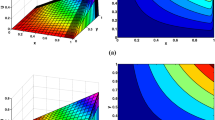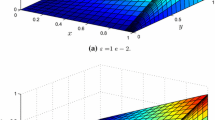Abstract
This article deals with a coupled system of singularly perturbed convection-diffusion parabolic partial differential equations (PDEs) possessing overlapping boundary layers. As the thickness of the layer shrinks for small diffusion parameter, efficient capturing of the solution and the diffusive flux (i.e., scaled first-order spatial derivative of the solution) leads to a difficult task. It is well-known that the classical numerical techniques have deficiencies in estimating the solution and the diffusive flux on equidistant mesh unless the mesh-size is adequately large. We aim to generate an efficient numerical approximation to the coupled system of PDEs by employing the implicit-Euler method in time and a classical finite difference scheme in space on a layer-adapted Shishkin mesh. Firstly, we discuss about parameter-uniform convergence of the numerical solution in \(C^0\)-norm followed by the error analysis for the scaled discrete space derivative and the discrete time derivative. Subsequently, the parameter-uniform error bound is established in weighted \(C^1\)-norm for global approximation to the solution and the space-time solution derivatives. The theoretical findings are verified by generating the numerical results for two test examples.











Similar content being viewed by others
Data Availability
No datasets were generated or analysed during the current study.
References
L. Uys, J.S. Hofmeyr, J. Rohwer, Coupling kinetic models and advection-diffusion equations. 1. framework development and application to sucrose translocation and metabolism in sugarcane. In Silico Plants 3, diab013 (2021)
C.D. Shackelford, D.E. Daniel, Diffusion in saturated soil. i: Background. J. Geotech. Eng. 117(3), 467–484 (1991)
M. Manassero, C.D. Shackelford, The role of diffusion in contaminant migration through soil barriers. Riv. Ital. Geotec. 28(1), 5–31 (1994)
G.I. Shishkin, L.P. Shishkina, Difference Methods for Singular Perturbation Problems (Chapman & Hall/CRC Press, Boca Raton, FL, 2009)
E.P. Doolan, J.J.H. Miller, W.H.A. Schildres, Uniform Numerical Methods for Problems with Initial and Boundary Layers (Boole Press, Dublin, 1980)
K. Mukherjee, S. Natesan, Parameter-uniform hybrid numerical scheme for time-dependent convection-dominated initial-boundary-value problems. Computing 84(3–4), 209–230 (2009)
N.S. Yadav, K. Mukherjee, Efficient parameter-robust numerical methods for singularly perturbed semilinear parabolic PDEs of convection-diffusion type. Numer. Algorithms (2023). https://doi.org/10.1007/s11075-023-01670-2
N. Madden, M. Stynes, A uniformly convergent numerical method for a coupled system of two singularly perturbed linear reaction-diffusion problems. IMA J. Numer. Anal. 23, 627–644 (2003)
S. Singh, D. Kumar, H. Ramos, An efficient parameter uniform spline-based technique for singularly perturbed weakly coupled reaction-diffusion systems. J. Appl. Anal. Comput. 13(4), 2203–2228 (2023)
K. Aarthika, V. Shanthi, H. Ramos, A finite-difference scheme for a coupled system of singularly perturbed time-dependent reaction-diffusion equations with discontinuous source terms. Int. J. Comput. Math. 98, 120–135 (2020)
T. Linß, Analysis of an upwind finite-difference scheme for a system of coupled singularly perturbed convection-diffusion equations. Computing 79, 23–32 (2007)
Z. Cen, Parameter-uniform finite difference scheme for a system of coupled singularly perturbed convection-diffusion equations. Int. J. Comput. Math. 82(2), 177–192 (2005)
R. Christy, A. Tamilselvan, N. Geetha, An analysis of overlapping schwarz method for a weakly coupled system of singularly perturbed convection-diffusion equations. Int. J. Numer. Methods Fluids 92(1), 528–544 (2020)
L. Liu, G. Long, Y. Zhang, Parameter uniform numerical method for a system of two coupled singularly perturbed parabolic convection-diffusion equations. Adv. Differ. Equ. 1, 450 (2018)
K. Aarthika, V. Shanthi, H. Ramos, A non-uniform difference scheme for solving singularly perturbed 1D-parabolic reaction-convection-diffusion systems with two small parameters and discontinuous source terms. J. Math. Chem. 58, 663–685 (2020)
M.K. Singh, S. Natesan, Numerical analysis of singularly perturbed system of parabolic convection-diffusion problem with regular boundary layers. Diff. Equ. Dyn. Syst. 30, 695–717 (2022)
S. Bose, K. Mukherjee, Numerical approximation of system of singularly perturbed convection-diffusion problems on different layer-adapted meshes, in Modeling, Simulation and Optimization. ed. by B. Das, R. Patgiri, S. Bandyopadhyay, V.E. Balas (Springer, Singapore, 2022), pp.523–535
O.A. Ladyzenskaja, V.A. Solonnikov, N.N. Ural‘ceva, Linear and Quasi-linear Equations of Parabolic Type, vol. 23 (American Mathematical Society, Providence, 1968)
J.J.H. Miller, E. O’Riordan, G.I. Shishkin, Fitted Numerical Methods for Singular Perturbation Problems (World Scientific, Singapore, 1996)
P.A. Farrell, A.F. Hegarty, J.J.H. Miller, E. O’Riordan, G.I. Shishkin, Robust Computational Techniques for Boundary Layers (Chapman & Hall/CRC Press, Boca Raton, 2000)
N. Kopteva, M. Stynes, Approximation of derivatives in a convection-diffusion two-point boundary value problem. Appl. Numer. Math. 39, 47–60 (2001)
R.M. Priyadharshini, N. Ramanujam, Approximation of derivative to a singularly perturbed second-order ordinary differential equation with discontinuous convection coefficient using hybrid difference scheme. Int. J. Comput. Math. 86(8), 1355–1365 (2009)
R.M. Priyadharshini, N. Ramanujam, V. Shanthi, Approximation of derivative in a system of singularly perturbed convection-diffusion equations. J. Appl. Math. Comput. 29(1–2), 137–151 (2009)
R.M. Priyadharshini, N. Ramanujam, Uniformly-convergent numerical methods for a system of coupled singularly perturbed convection-diffusion equations with mixed type boundary conditions. Math. Model. Anal. 18(5), 577–598 (2013)
S. Bose, K. Mukherjee, A fast uniformly accurate global numerical approximation to solution and scaled derivative of system of singularly perturbed problems with multiple diffusion parameters on generalized adaptive mesh. Comput. Appl. Math. 42(180), 1–52 (2023)
J.L. Gracia, E. O’Riordan, Numerical approximation of solution derivatives of singularly perturbed parabolic problems of convection-diffusion type. Math. Comput. 85(298), 581–599 (2016)
M.K. Singh, S. Natesan, Richardson extrapolation technique for singularly perturbed system of parabolic partial differential equations with exponential boundary layers. Appl. Math. Comput. 333, 254–275 (2018)
M. Stynes, E. O’Riordan, A uniformly convergent Galerkin method on a Shishkin mesh for a convection-diffusion problem. J. Math. Anal. Appl. 214(1), 36–54 (1997)
R.B. Kellogg, A. Tsan, Analysis of some differences approximations for a singular perturbation problem without turning point. Math. Comput. 32(144), 1025–1039 (1978)
Acknowledgements
The authors express their sincere thanks to the anonymous reviewer for the valuable suggestions. The first author wishes to acknowledge Council of Scientific and Industrial Research, India, for the research grant 09/1187(0004)/2019-EMR-I during his Ph.D.
Author information
Authors and Affiliations
Contributions
Both the authors have equally contributed to the manuscript.
Corresponding author
Ethics declarations
Conflict of interest
The authors declare that they have no conflict of interest.
Additional information
Publisher's Note
Springer Nature remains neutral with regard to jurisdictional claims in published maps and institutional affiliations.
Proof of Lemma 4.3
Proof of Lemma 4.3
Proof
We derive bound of the truncation error by considering two subregions for \(x_i\in (1-{\uptheta }_{\varepsilon _1}^{1}, 1]\) and \(x_i\in (1-{\uptheta }_{\varepsilon _2}^{1},1-{\uptheta }_{\varepsilon _1}^{1}]\).
-
(i)
Let \(x_i \in (1-{\uptheta }_{\varepsilon _1}^{1}, 1]\). Then, for \(\displaystyle 3N/4< i < N\), by using Lemma 2.2 and the method of [29], Lemma 3.3], and since \(\frac{\varepsilon _1}{\varepsilon _2} <1, \text {sinh}\xi \le \xi ,\) we obtain that
$$\begin{aligned}&\Big |\Big (\delta _{t}^{-}+\texttt{L}_{x,\varepsilon _1}^{N, \Delta t}\Big )(\vec {Q}-\vec {q})(x_i, t_m)\Big |\nonumber \\&\quad \le \text {C} \Bigg [\Delta t+\varepsilon _1^{-1}\mathfrak {B}_{\varepsilon _1}(1-x_{i})(\upbeta \texttt{H}^2/\varepsilon _1)+ \varepsilon _2^{-1}\mathfrak {B}_{\varepsilon _2}(1-x_{i})(\upbeta \texttt{H}^2/\varepsilon _2)\Bigg ]\nonumber \\&\quad \le \text {C} \Bigg [\Delta t+(\varepsilon _1^{-1}\mathfrak {B}_{\varepsilon _1}(1-x_{i})+\varepsilon _2^{-1}\mathfrak {B}_{\varepsilon _2}(1-x_{i}))N^{-1}\ln N\Bigg ], \end{aligned}$$and similar bound can be obtained for \(\Big (\delta _{t}^{-}+\texttt{L}_{x,\varepsilon _2}^{N, \Delta t}\Big )(\vec {Q}-\vec {q})(x_i, t_m)\).
-
(ii)
Let \(x_i \in (1-{\uptheta }_{\varepsilon _2}^1, 1-{\uptheta }_{\varepsilon _1}^1]\). Since, \(\varepsilon _1^{-2}\exp (-\upbeta (1-\xi )/\varepsilon _1) \le \varepsilon _2^{-2}\exp (-\upbeta (1-\xi )/\varepsilon _2)\), for \(1-\xi > 2\varepsilon _1/\upbeta \), we deduce for \(\displaystyle N/2+\sum _{j=1}^{\Bbbk -1}N_{j} < i \le N/2 + \sum _{j=1}^{\Bbbk }N_{j},\) that
$$\begin{aligned} \Big |\Big (\delta _{t}^{-}+\texttt{L}_{x,\varepsilon _1}^{N, \Delta t}\Big )(\vec {Q}-\vec {q})(x_i, t_m)\Big |&\le \text {C} \Big [\Delta t+\varepsilon _2^{-1}\mathfrak {B}_{\varepsilon _2}(1-x_{i})(\upbeta \texttt{H}^1/\varepsilon _2)\Big ]\nonumber \\&\le \text {C}\Big [\Delta t+ \varepsilon _2^{-1}\mathfrak {B}_{\varepsilon _2}(1-x_i)N^{-1}\ln N\Big ], \end{aligned}$$where \(\upbeta \texttt{H}^1 \le \text {C}\varepsilon _2N^{-1}\ln N\); and similarly, one can derive the bound for \(\Big (\delta _{t}^{-}+\texttt{L}_{x,\varepsilon _2}^{N, \Delta t}\Big )(\vec {Q}-\vec {q})(x_i, t_m)\).
Now, we consider the following discrete functions:
where \(\vec {\lambda }=(\lambda _1, \lambda _2)^{T}\) is defined as,
where \(\vec {\Uptheta }_{2, i}=(\Uptheta _{2, i}, \Uptheta _{2, i})^{T}, \vec {\Uptheta }_{1, i}=(\Uptheta _{1, i}, -\Uptheta _{1, i})^{T}\). Since, \(\texttt{H}^1 =O(\varepsilon _2)\), \(\texttt{H}^2=O(\varepsilon _1)\), and \(\varepsilon _1 < \varepsilon _2\), from Lemma 3.2, we obtain that
Hence, for \(N/2< i < N\), using (A.1), since \(\mathfrak {B}_{\varepsilon _r}(1-x_i)=e^{-\upbeta (1-x_i)/\varepsilon _r} \le \displaystyle (\Uptheta _{r,i}/\Uptheta _{r,N}),~~ r=1, 2,\) we have
Now, using Lemma 4.2, we get
Also, \( \vec {\lambda }(x_N, t_m)=\displaystyle \Bigg [\vec {\text {C}}\Big (\Delta t+N^{-1}(1+x_{i})\Big )+ \text {C}\Big ( \Uptheta _{1,N}^{-1}\vec {\Uptheta }_{1,N}+\Uptheta _{2,N}^{-1}\vec {\Uptheta }_{2,N}\Big ) N^{-1}\ln N\Bigg ]\ge \vec {0}.\)
Thus,
Afterwards, we consider \(\vec {\lambda }(x_i,0)\), for \(N/2\le i\le N\). Clearly, \(\lambda _1(x_i, 0) \ge 0,\quad \) for \(N/2\le i\le N\). Next, for \(\displaystyle N/2 < i \le 3N/4,\) it is obvious that \(\lambda _2(x_i, 0) \ge 0\). For \(\displaystyle 3N/4 < i \le N,\) we have
Since \(0< \Big ((\Uptheta _{2, i}/\Uptheta _{2, N})-(\Uptheta _{1,i}/\Uptheta _{1,N})\Big )<(\Uptheta _{2, i}/\Uptheta _{2, N}) <1.\) Thus, \(\lambda _2(x_i, 0) \ge 0, ~\text {for}~N/2 \le i \le N.\) Therefore, we have
Thus, from (A.2)-(A.5), and by using discrete minimum principle (Lemma 3.1) to \(\vec {\psi }^\pm \) over the domain, \(\overline{\mathscr {D}}^{N, \Delta t}\cap ([1-{\uptheta }_{\varepsilon _2}^1, 1]\times [0, T]),\) we have
Afterwards, we establish the required estimate for \((\vec {Q}-\vec {q})(x_i, t_m)\) as stated in Lemma 4.3 by deriving the bound for \(\vec {\lambda }(x_i, t_m)\).
Let us consider two subregions for \(x_i\in (1-{\uptheta }_{\varepsilon _1}^{1}, 1]\) and \(x_i\in (1-{\uptheta }_{\varepsilon _2}^{1},1-{\uptheta }_{\varepsilon _1}^{1}]\).
-
(i)
Let \(x_i \in (1-{\uptheta }_{\varepsilon _1}^{1}, 1]\). For \(\displaystyle 3N/4 < i \le N,\) we have
$$\begin{aligned}&\displaystyle \lambda _1(x_i, t_m)\le \text {C}\Big [\Delta t+N^{-1}+ \Big ((\Uptheta _{1,i}/\Uptheta _{1,N})+(\Uptheta _{2, i}/\Uptheta _{2, N}) \Big )N^{-1} \ln N\Big ]\\&\quad \le \text {C}\Big [\Delta t +N^{-1}+N^{-1}\ln N\Big ], \\&\displaystyle \lambda _2(x_i, t_m) \le \text {C}\Big [\Delta t+N^{-1}+ \Big ((\Uptheta _{2, i}/\Uptheta _{2, N})-(\Uptheta _{1, i}/\Uptheta _{1, N})\Big )N^{-1}\ln N \Big ]\\&\quad \le \text {C}\Big [\Delta t + N^{-1}+N^{-1}\ln N\Big ],\! \quad \text {since} \!\quad 0< \Big ((\Uptheta _{2, i}/\Uptheta _{2, N})-(\Uptheta _{1, i}/\Uptheta _{1, N})\Big ) <1. \end{aligned}$$ -
(ii)
Let \(x_i \in (1-{\uptheta }_{\varepsilon _2}^1, 1-{\uptheta }_{\varepsilon _1}^1]\). For \(\displaystyle N/2 < i \le 3N/4\), we have
$$\begin{aligned} \displaystyle \lambda _1(x_i, t_m) \le&\text {C}\Big [\Delta t+N^{-1}+ (\Uptheta _{2, i}/\Uptheta _{2, N}) N^{-1}\ln N\Big ] \\ \le&\text {C}\Big [\Delta t+N^{-1}+N^{-1}\ln N\Big ],\quad \end{aligned}$$since \((\Uptheta _{2, i}/\Uptheta _{2, N}) < 1\). Similarly, \( \displaystyle \lambda _2(x_i, t_m) \le \text {C}\Big [\Delta t+N^{-1}+N^{-1}\ln N\Big ].\)
Thus, we have
$$\begin{aligned} \vec {\lambda }(x_i, t_m)\le {\left\{ \begin{array}{ll} \displaystyle \vec {\text {C}}\Big [\Delta t+\text {max}\{N^{-1},N^{-1}\ln N\}\Big ], \quad \text {for}~x_i \in (1-{\uptheta }_{\varepsilon _2}^1, 1-{\uptheta }_{\varepsilon _1}^1], \\ \vec {\text {C}}\Big [\Delta t +N^{-1}+ N^{-1}\ln N \Big ], \quad \text {for}~x_i \in (1-{\uptheta }_{\varepsilon _1}^{1}, 1]. \end{array}\right. } \end{aligned}$$
Hence, the proof is over. \(\square \)
Rights and permissions
Springer Nature or its licensor (e.g. a society or other partner) holds exclusive rights to this article under a publishing agreement with the author(s) or other rightsholder(s); author self-archiving of the accepted manuscript version of this article is solely governed by the terms of such publishing agreement and applicable law.
About this article
Cite this article
Bose, S., Mukherjee, K. Efficient approximation of solution derivatives for system of singularly perturbed time-dependent convection-diffusion PDEs on Shishkin mesh. J Math Chem 62, 1134–1174 (2024). https://doi.org/10.1007/s10910-024-01587-8
Received:
Accepted:
Published:
Issue Date:
DOI: https://doi.org/10.1007/s10910-024-01587-8
Keywords
- System of singularly perturbed convection-diffusion IBVPs
- Overlapping boundary layers
- Standard Shishkin mesh
- Scaled discrete space derivative
- Discrete time derivative
- Parameter-uniform convergence




